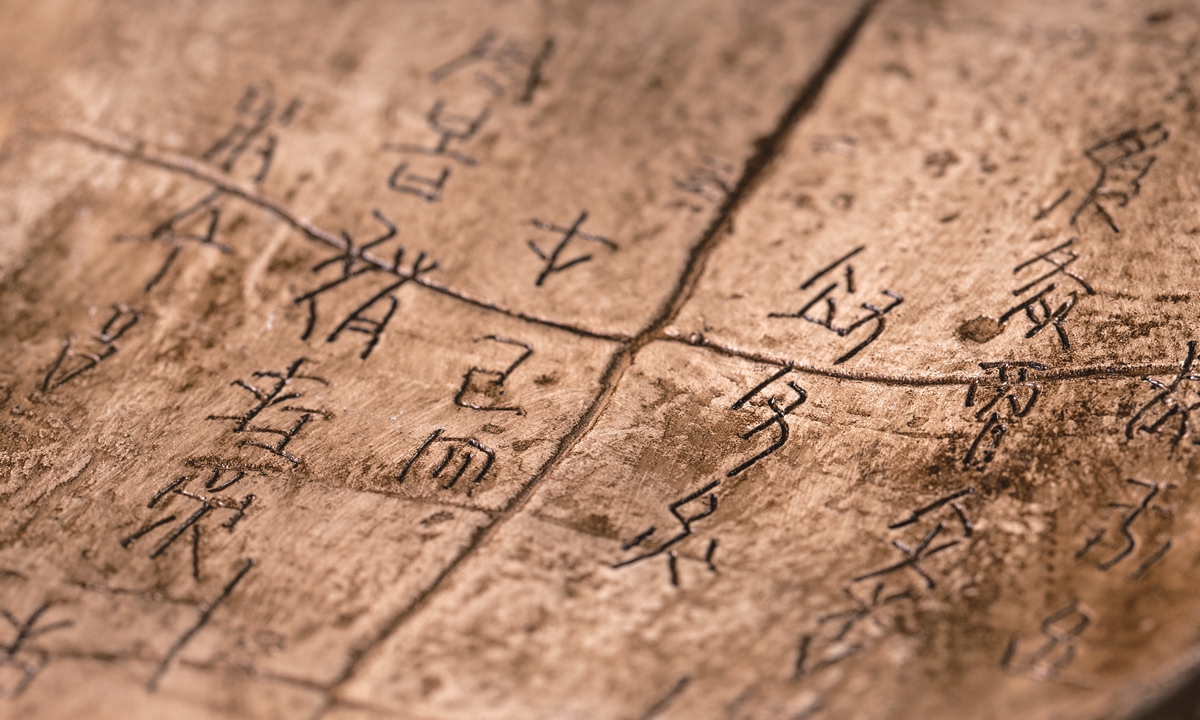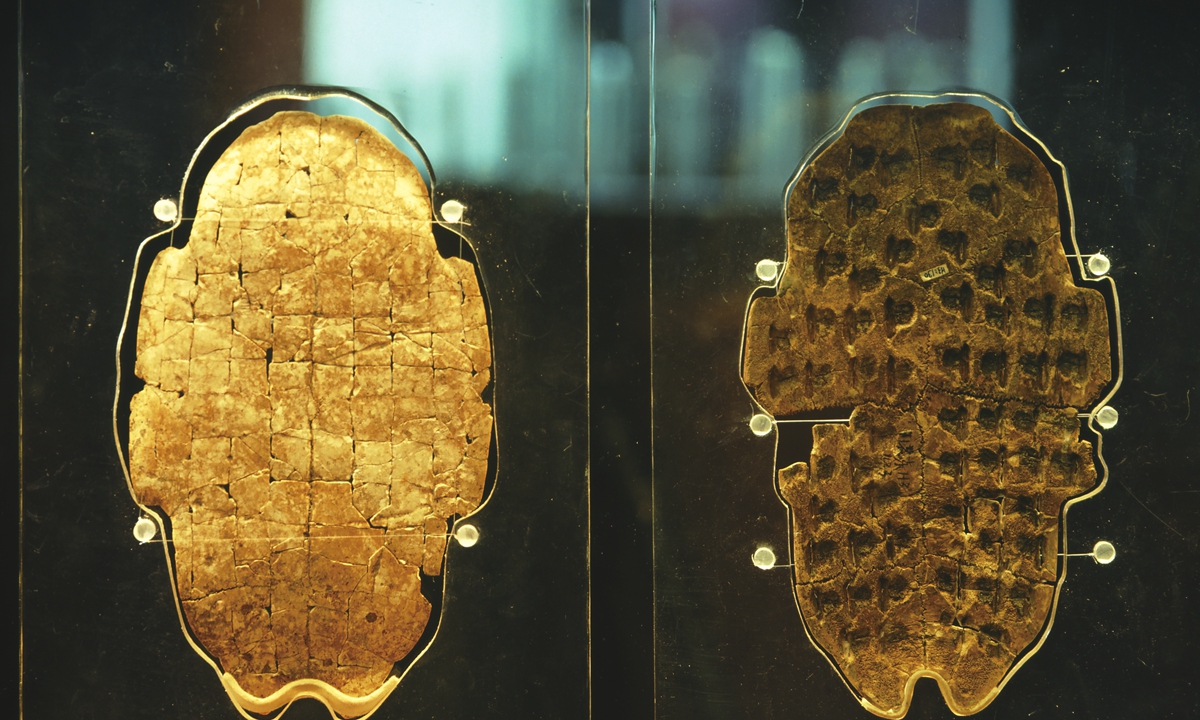
Shang Dynasty oracle bones with inscriptions of ancient Chinese characters Photo: VCG
Editor's Note:
Xi Jinping, general secretary of the Communist Party of China (CPC) Central Committee, inspected the Yinxu Ruins, the last capital of the Shang Dynasty (c.1600BC-1046BC), in Anyang, Central China's Henan Province, on Friday.
"I have long yearned to visit here. This time I came here for further study and to gain a deeper understanding of Chinese civilization so that we can make the past serve the present, and draw inspiration for building an even better modern Chinese civilization," he said.
Xi also noted that the oracle bone inscriptions, or
jiaguwen, unearthed at the Yinxu Ruins are important evidence of the Chinese written language 3,000 years ago that helped push the date of written Chinese history up by nearly 1,000 years. Chinese characters are extraordinary and have served as a keystone in the formation and development of the Chinese nation. Archaeologists have done a great job in researching their origins. "With a long and continuous history stretching back to antiquity, Chinese civilization shaped our great nation, and this nation will continue to be great," Xi added.
Why is the oracle bone script seen as China's earliest writing system? What events was this script used to record? The Global Times talked to various scholars and archaeologists to find the answers to these questions and take readers into the world of the late Shang Dynasty.

Shang Dynasty oracle bones with inscriptions of ancient Chinese characters Photo: VCG
It all starts with the Yinxu Ruins, home to the remains of wooden structures, a palace and royal tombs, as well as smaller objects such as bronze ritual vessels, jade and bone carvings, ceramics and the oracle bones - inscribed with the earliest evidence of the Chinese written language.
"The discovery of oracle bone inscriptions at the Yinxu Ruins had profound cultural significance," Chen Lüsheng, a renowned museologist and researcher at the National Museum of China, told the Global Times on Sunday.
He explained that oracle bone inscriptions mainly recorded the social development, economic status and daily lives of people, thereby allowing researchers to better understand the society of the late Shang Dynasty.
Mature system First discovered in 1899, oracle bone inscriptions were included on the UNESCO Memory of the World Register in 2017. Around 160,000 oracle bones have been found so far, but of the 4,300 characters inscribed on them, only 1,600 have been decoded, according to a report from the Xinhua News Agency.
Oracle bones were used during divination rites and ceremonies worshiping the gods held by the late Shang people.
During these rites, the diviner would pose a question and then take a hot poker and apply it to the bones, mainly turtle plastrons (the hard undershell) and ox scapulas (shoulder bones). The heat from the poker would cause cracks to appear on the bones and these cracks would then be interpreted to determine the answer to the question.
To keep a record of the ceremony, Chinese characters were carved onto the bones, with these inscriptions ranging from less than 10 characters to over 100 characters in rare cases.
According to Sun Guoding, a Beijing-based archaeologist specializing in the Shang Dynasty, the inscriptions cover all aspects of Shang Dynasty society, from religious ceremonies and the affairs of kings to the weather and harvests, as well as births, illnesses and deaths in the royal family.
This detailed information has provided invaluable insight into late Shang Dynasty civilization as well as society.
While oracle bones were mainly used for divination purposes, Yang Yimin, an oracle bone researcher, told the Global Times that the writing system was already very mature, which hints at an even earlier origin for Chinese characters.
As one of the earliest known Chinese scripts, oracle bone inscriptions are extremely important for research into the original configuration of Chinese characters and early grammar.
Continuous lineTraditionally, what is known about the history of the Shang Dynasty was recorded in texts written centuries after the reign of its kings came to an end.
In this respect, the discovery of the oracle bone inscriptions was extremely significant because they helped confirm, and in some cases correct, the events and history laid out in ancient texts such as the Han Dynasty (206BC-AD220) Records of the Grand Historian, China's first biographical history work.
"They advanced the history of Chinese civilization recorded in writing by 1,000 years," Liu Zheng, a member of the China Cultural Relics Academy, told the Global Times.
"At the Xiaoshuangqiao Ruins in Zhengzhou, Henan Province, we have found another type of written language documented in cinnabar pigment on pottery dating to 100 years earlier than oracle bones," said Sun.
"The two look incredibly similar, which demonstrates the continuity of Chinese civilization. The civilization of the Central Plains was always evolving," Sun added.
The future of archaeology
Many of the oracle bones have been scattered across the world over the past century, making it more difficult for researchers to study them.
Fortunately, since the founding of the People's Republic of China in 1949, Chinese experts have published three books on the ancient scripts, compiling over 70,000 oracle bones.
The Chinese Academy of Social Sciences is working with public and private collectors around the country to compile details of another 10,000 oracle bones for further research, says the Xinhua report.
The Anyang-based National Museum of Chinese Writing, which opened in 2009, has made the inscriptions more popular with younger people, thereby becoming "an important way to inherit and develop the Yinxu Ruins' oracle bone inscription culture and Chinese character culture," according to Liu.
The discoveries at the Yinxu Ruins have had a profound influence but there are still many secrets waiting for younger generations of researchers to explore. At present, Chinese archeology has developed diverse high-tech excavation and research methods, which create unlimited prospects for researching the Yinxu Ruins, Chen said.
"Promoting the archaeological achievements at the Yinxu Ruins is also very important, especially for furthering young people's understanding of history and stimulating their interest in archaeology. They are the future of Chinese archaeology," Chen added.





